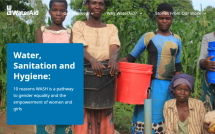Water, Sanitation and Hygiene: 10 Reasons WASH is a Pathway to Gender Equality and the Empowerment of Women and Girls
On June, 9, 2017, the Government of Canada released its Feminist International Assistance Policy (FIAP) to advance gender equality and the empowerment of women and girls.
Water, Sanitation & Hygiene: A pathway to realizing gender equality and the empowerment of women and girls, a position paper developed by the Canadian water, sanitation and hygiene sector (WASH), illustrates how WASH is a critical pathway to transforming gender relations and supporting women and girls as agents of change to lead healthy lives and participate in social, economic and political activity.
The effects of a lack of clean water and decent toilets are felt most by women and girls. Investing in WASH is critical to fulfilling basic human needs and realizing the health and rights of women and girls.
The 10 reasons are as follows:
Women and girls are empowered when they have control over the resources to meet their WASH needs and participate in the provision of WASH services.
WASH is a pillar of public health.
WASH is a determining factor for nutrition outcomes.
Investments in WASH contribute to reducing sexual and gender-based violence.
Investments in WASH reduce the burden of unpaid work on women and girls, and facilitate participation in education, employment, leisure activities and decision-making.
Appropriate water and sanitation facilities in schools leads to better education and health outcomes for girls and boys and supports girls’ menstrual hygiene management.
Water and sanitation services provide economic opportunities for women.
WASH is an important entry point to build national and local government capacity to meet the needs of women and girls.
WASH services are critical for meeting the basic needs of women and girls in humanitarian and fragile contexts.
The impact of climate change will increasingly test the resilience of sanitation systems and the availability of safe water owing to floods, droughts and extreme weather patterns, impacting vulnerable communities around the world.
Last modified: June 25, 2019
Language: English

